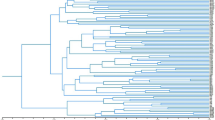Abstract.
Little is known about genetic variation in members of the genus Aesculus (Hippocastanaceae), in particular A. flava (yellow buckeye) and A. glabra (Ohio buckeye). Here, three synthetic DNA probes (composed of tandemly repeated, core sequences) that reveal alleles at multiple variable-number tandem-repeat (VNTR) loci in these two species were used to investigate: 1) levels of genetic variation in one stand of A. flava and three isolated stands of A. glabra; 2) whether the stands of A. glabra are genetically differentiated from one another; 3) whether there has been selection for more heterozygous individuals through time in one stand each of A. flava and A. glabra; and 4) whether a possible genetic bottleneck had occurred during the formation of either species of Aesculus.
First, variation of VNTR genetic markers within and among three populations of A. glabra separated by 60–180 km was examined. In each one hectare (ha) population, 22 individuals were randomly sampled. Among the three populations, the mean number of bands scored per individual was 80.35 and the average number of estimated loci surveyed was 54.17. Mean similarity and estimated heterozygosity within populations ranged from 0.634 to 0.743 and from 0.342 to 0.486, respectively. The mean similarity across populations was 0.657, while the mean estimated heterozygosity across populations was 0.484 for A. glabra. The most isolated site was the most genetically differentiated as indicated by differences in levels of similarity, heterozygosity, and Fst value comparisons.
In a separate experiment, genetic variation in 22 large (reproductively mature; dbh > 8 cm) individuals was compared with that in 22 small (not yet reproductive; dbh < 1 cm) individuals collected within one ha stands for both A. flava and A. glabra. Mean similarity values among large versus small individuals of A. flava were 0.665 versus 0.662, while for A. glabra the corresponding values were 0.686 versus 0.691, respectively. Permutation tests of these similarity data detected no evidence for size class genetic differentiation in either species (both p-values > 0.050). Further, permutation tests for the number of bands per individual (average band number should be higher in more heterozygous individuals) detected no significant differences between size classes for either species. Thus, evidence of pronounced inbreeding and/or selection altering population genetics within small relative to large individuals was not detected.
In addition, comparable similarity and heterozygosity values between these two closely related species (which still maintain an active zone of hybridization) suggests that either: 1) no extreme genetic bottleneck has accompanied the formation of these species from a common ancestor; or 2) signs of such a bottleneck have largely been eliminated. These studies demonstrate the utility of multilocus VNTR DNA probes for investigating genetic variation within and among plant populations, between size classes within a population, and between closely related species.
Similar content being viewed by others
Author information
Authors and Affiliations
Additional information
Received May 15, 1998 Accepted September 11, 2001
Rights and permissions
About this article
Cite this article
Lim, H., Pelikan, S. & Rogstad, S. Genetic diversity among populations and size classes of buckeyes (Aesculus: Hippocastanaceae) examined with multilocus VNTR probes. Plant Syst. Evol. 230, 125–141 (2002). https://doi.org/10.1007/s006060200000
Issue Date:
DOI: https://doi.org/10.1007/s006060200000




